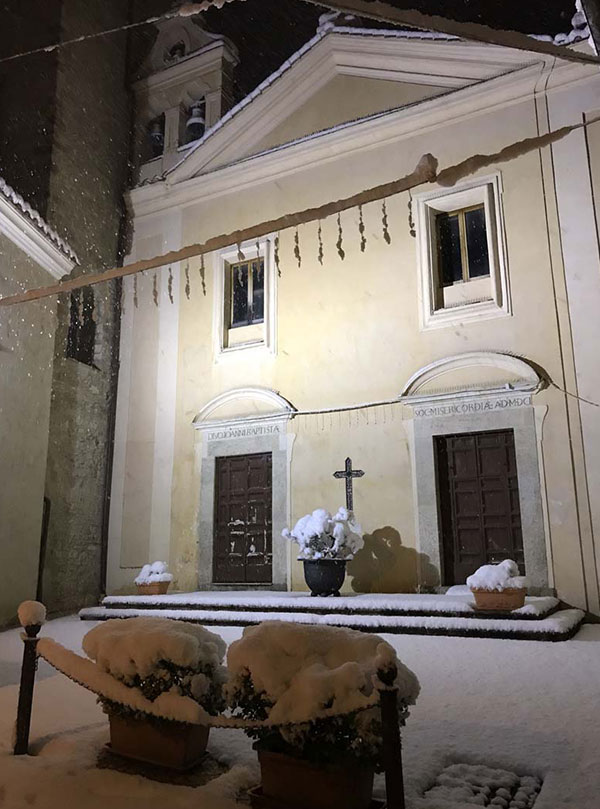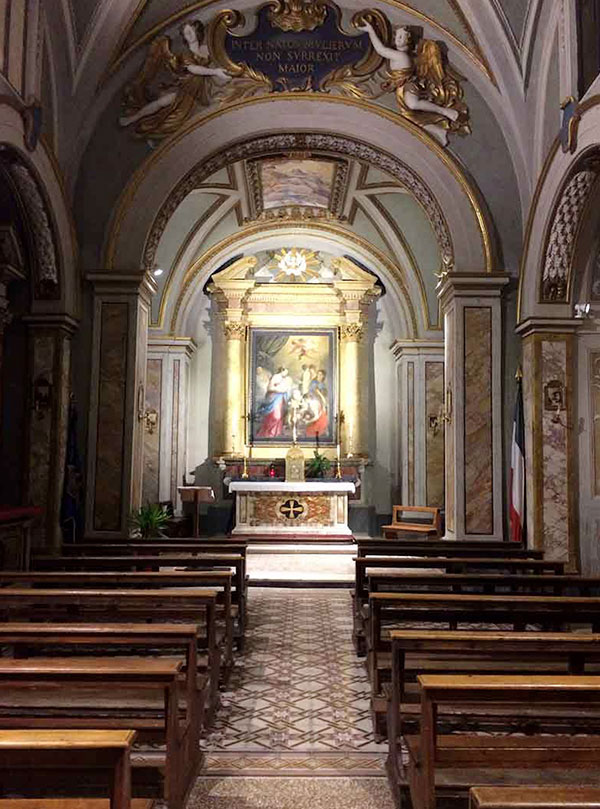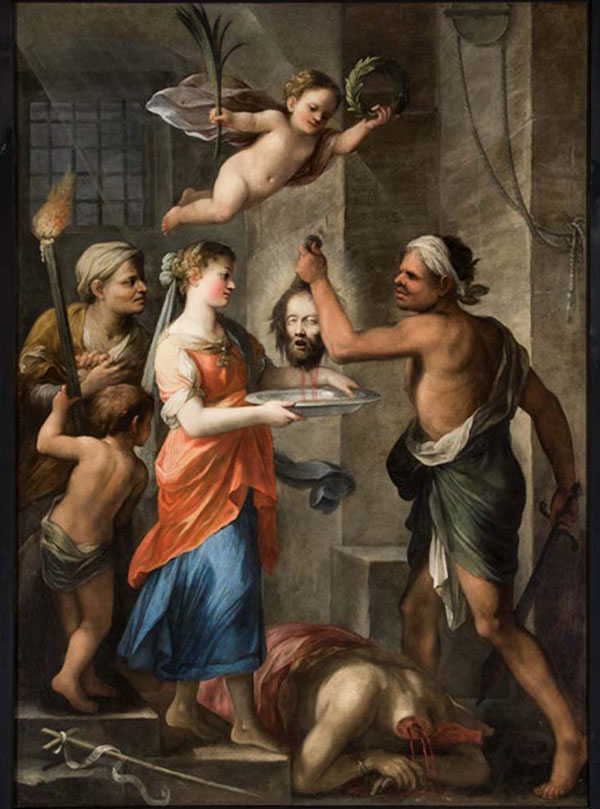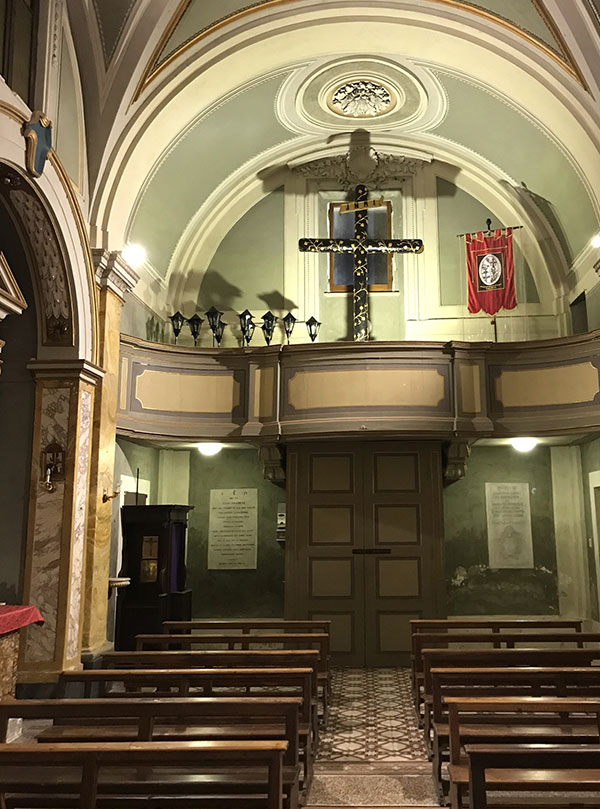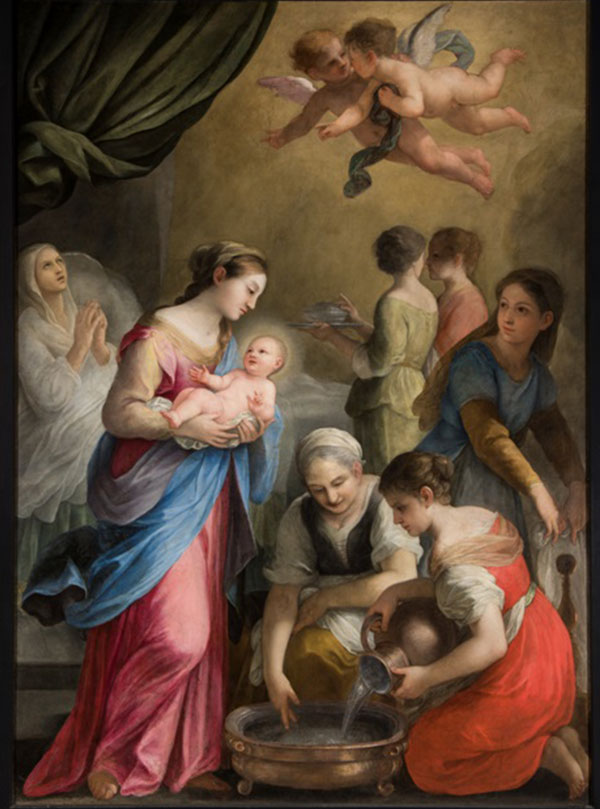The church is said to have been built to the design of Angelo Savi da Parma. In 1720 the church was later restored to a design by Alessandro Specchi.The church is dedicated to St. John the Baptist and was erected in 1601
Church of San Giovanni Battista

Position
Piazza Mario Dottori, 18
02047 – Poggio Mirteto (RI)

Opening hours
Saturday from 8:00 a.m. to 10:00 a.m. or by reservation
The church is said to have been built to the design of Angelo Savi da Parma. In 1720 the church was later restored to a design by Alessandro Specchi.
The church is dedicated to St. John the Baptist and was erected in 1601 in the Municipality of Poggio Mirteto, as stated on the lintel of the two doors on the facade.
DIVO IOANNI BAPTISTAE SOC. MISERICORDIAE AD MDCI
(St. John the Baptist Society of Mercy in the year of our Lord 1601).
The Society or Company of Mercy was first founded in Poggio Mirteto in 1570 and was later recognized with a legal title in 1610. Its place of worship was the church of St. John the Baptist, which it ran independently with a chaplain and rents from land and buildings.
The church was also used as a burial place until the early 1800s, when a law forbade burying the dead within the walls of inhabited places. The dead were also buried under the church, which was accessed by a staircase descending from the adjacent sacristy.
The Society of Mercy had a major identity crisis in 1814, when the recovery of assets taken from the Society during French rule was only minimally possible.
In the mid-nineteenth century the Misericordia Society became known as the Confraternity of Mercy, Death and Oracion.
It is interesting to see, on the facade, the bell gable, which replaced the bell tower when Cardinal Lambruschini wanted to give more space to the seminary, which he had moved from S. Salvatore Maggiore to Poggio Mirteto in 1837.
On two of the three bells we read that they were made at their own expense by the Society of Mercy in 1774, under the pontificate of Clement XIV, the “protector,” and there is also a reproduction of the Pope’s coat of arms. To understand better, it is necessary to know that Fra Lorenzo Ganganelli, a Conventual friar and future pope under the name of Clement XIV (1769-1774, had been in the Convent of St. Valentine in Poggio Mirteto). After becoming cardinal, the Compassionate Sisters of Mercy asked him to be their protector. One of the two autograph letters found in the parish archives is the cardinal’s reply, in which he writes that he would be happy to accept. The Protectorate remained even when Frair Lorenzo became Pope.
We enter the church
The church has a single nave with two chapels on the right side and two chapels on the left side.
In the chancel, the main altarpiece is peculiar: it is decorated on both sides. On one side is depicted the birth of John the Baptist, and on the other is John the Baptist beheaded and a servant carrying his head to Herodias’ daughter.
The picture was originally a processional banner, painted by Plautilla Bricci (Rome 1616-1690), made for the Holy Year of 1675.
Oil painting on canvas. Last restored in 1992.
The first chapel, to the right of the entrances.
It is dedicated to Our Lady of Mount Carmel, depicted in the 17th-century painting. The two saints praying to Our Lady are St. Anthony of Padua, who receives the scapular, and St. Philip Neri. At the top it reads, “DECOR CARMELI” (decoration of Carmel).
The second chapel.
is dedicated to S. Gaetano. The picture represents the upper SS: Trinity, down, in a contemplative attitude, S. Gaetano is writing the Theatine Rules and St. Francesco Saverio in a white cotta and white stola.
The word “MAIN PATRON” indicates S. Gaetano as the Principal Patron of Poggio Mirteto.
This altar is the most important of the church, because here arises the devotion towards S. Gaetano. The first solemn celebration of the saint was celebrated in 1698, just 27 years after Pope Clement the X had proclaimed him Saint (April 12, 1671).
The feast that was celebrate each year until 1805, was always run by the Deputies of the Society of Mercy. Of particular value is also the painting of 1745.
The Company of Mercy had commissioned the canonical d. Sebastiano Picchi and Cavaliere Clemente Maria Amici to go to Rome an order the painting to a famous painter. Everyone was convinced that the painting had been painted by Cav. Sebastiano Conca (Gaeta 1680- Naples 1764) to whom were given 65 shields, but in the receipt, which he released, Cav. Conca claims to receive the money not for himself, but on behalf of Gaspero Serenario, author of the painting (Palermo 1707-1759. After 1730 Gaspero Serencitio moved from Palermo to Rome, where he had joined the Conca circle).
The Company of Mercy had also done in 1777 the statue of S. Gaetano “similar to the one which is still today in the church of S. Rocco. The statue, which was solemnly taken out in the procession in honor of St. Gaetano, came out and went back into the church of S.Giovanni, where it was kept securely. Only in 1970 the statue was taken to the Cathedral, where it can be admired on the altar of S. Gaetano.
The first chapel on the left side of the entrance.
Is dedicated to the Crucifix (sec. XVII). On top the text: IN HOC VINCES ( with this symbol you will win)
Next is a niche with processional statue of St. Antonio Abate.
The second chapel
It’s dedicated to the Madonna. Her imagine with the Child occupies the upper part of the painting, on the lower left there is S. Pio V, which receives inspiration from the Holy Spirit (A Dove), and on the right S. Francesco di Paola, offering a burning heart to Madonna (the saint’s motto is Charitas).
Above an inscription:” AVE MARIA”.
Oil paint on Canvas, sec. XVII, Last Restore 1992.







